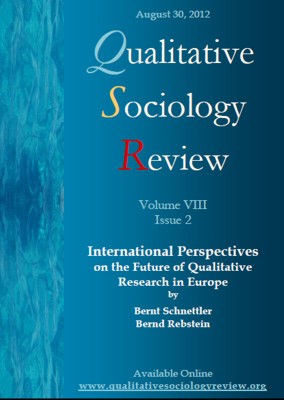Bridging the Gap: Image, Discourse, and Beyond – Towards a Critical Theory of Visual Representation
DOI:
https://doi.org/10.18778/1733-8077.8.2.05Keywords:
Discourse Analysis, Critical Theory, Dialectics, Picture Theory, Picture Analysis, Visual Representation, Visual Politics, Pictorial TurnAbstract
Pictures and images play a central role in contemporary society. Not only do they mediate meaning in a seemingly universal language (Fromm 1981), but their relevance for the construction of perception and beliefs cannot be underestimated. In global, political and religious discourses, controversies often revolve around images. The influence visuality has on the forming of ideas has already been discussed in the 1930s (Freud 1932). Today, even neurobiologists acknowledge the influential power of mental images (Hüther 2004).
But, despite the well acknowledged impact the Pictorial Turn has had up to date, discourse analyses are typically carried out solely on linguistic material. Nevertheless, even in the Foucauldian sense the term “discourse” relates to epistemes and power not only conveyed by language, but also by pictures and images, in “a mushy mixture of the articulable and the visible” (Deleuze 2006).
Nonetheless, the specific characteristics of pictures and images render analysis ever more difficult. Visual representations are a case sui generis. They cannot be transcribed into language completely. Research on visual artifacts can be put to work as a disclosure of how symbolic orders and the accordant identities are constructed. Something present, a picture or an image, is analyzed with regard to its ideological implications, as studies related to Cultural Studies usually do. Yet, beyond the visible picture, if representation is the making-present of something that’s absent (Pitkin 1967), what respectively who is being made absent by the presence of the visible? The ambiguity of representation as “standing for” versus “depiction of” might at the same time enable a critical approach in the analysis of visual discourse.
In this article, I attempt to conceptualize a methodological approach for conducting discourse analyses on visual material. For this purpose, I will introduce a dialectical notion of representativeness as imagery that draws on Gayatri C. Spivak’s critique and Hannah Fenichel Pitkin’s Political Theory of representation, as well as on Siegfried Kracauer’s deliberations on film. Finally, I am going to give an example for putting this approach into research practice.
Downloads
References
Angermüller, Johannes. 2001. “Einleitung: Diskursanalyse: Strömungen, Tendenzen, Perspektiven.” Pp. 7-22 in Diskursanalyse: Theorien, Methoden, Anwendungen, edited by J. Angermüller, K. Bunzmann, M. Nonhoff. Hamburg: Argument.
Google Scholar
Bohnsack, Ralf. 2009. Qualitative Bild- und Videointerpretation. Die dokumentarische Methode. Opladen and Farmington Hills: Barbara Budrich.
Google Scholar
DOI: https://doi.org/10.1007/978-3-8349-9441-7_20
Bredekamp, Horst. 2006. “«On Movies». Erwin Panofsky zwischen Rudolf Arnheim und Walter Benjamin.” Pp. 239- 252 in Bildtheorie und Film, edited by T. Koebner, T. Meder in alliance with Fabienne Liptay. Munich: edition text+kritik.
Google Scholar
Deleuze, Gilles. 2006. Foucault. London, New York: Continuum.
Google Scholar
Fiske, John. 2000. Lesarten des Populären. Wien: Turia und Kant.
Google Scholar
Foucault, Michel. 2007. The Archaeology of Knowledge. Translated by Tavistock Publications Limited. London, New York: Routledge.
Google Scholar
Freud, Sigmund, (ed.). 1932. “Revision der Traumlehre.” Pp. 11-29 in Neue Folge der Vorlesungen zur Einführung in die Psychoanalyse. Frankfurt am Main: Fischer.
Google Scholar
Fromm, Erich. 1981. Märchen, Mythen, Träume. Eine Einführung in das Verständnis einer vergessenen Sprache. Reinbek bei Hamburg: Rowohlt.
Google Scholar
Hepp, Andreas. 2010. Cultural Studies und Medienanalyse. Eine Einführung. 3., überarb. u. erw. Auflage. Opladen, Wiesbaden: VS Verlag.
Google Scholar
DOI: https://doi.org/10.1007/978-3-531-92190-7
Hüther, Gerald. 2004. Die Macht der inneren Bilder. Wie Visionen das Gehirn, den Menschen und die Welt verändern. Gottingen: Vandenhoek & Ruprecht.
Google Scholar
Jäger, Siegfried. 2009. Kritische Diskursanalyse. Eine Einführung. Munster: Unrast.
Google Scholar
Keller, Reiner, Andreas Hirseland, Werner Schneider et al., (eds.). 2003. “Die vielgestaltige Praxis der Diskursforschung – Eine Einführung.” Pp. 7-18 in Handbuch Sozialwissenschaftliche Diskursanalyse. Band II: Forschungspraxis. Wiesbaden: VS-Verlag.
Google Scholar
DOI: https://doi.org/10.1007/978-3-322-99674-9_1
Kellner, Douglas. 1997. “Critical Theory and Cultural Studies: The Missed Articulation.” Pp. 12-41 in Cultural Methodologies, edited by J. McGuigan. London, Thousand Oaks, New Delhi: Sage.
Google Scholar
Koch, Gertrud. 1992. Die Einstellung ist die Einstellung. Visuelle Konstruktionen des Judentums. Frankfurt am Main: Suhrkamp.
Google Scholar
Kracauer, Siegfried, (ed.). 1995. “The Little Shopgirls Go to the Movies.” Pp. 291-304 in The Mass Ornament: Weimar Essays. Cambridge, London: Harvard University Press.
Google Scholar
Lacey, Nick. 1998. Image and Representation. Key Concepts in Media Studies. Houndmills: Palgrave Macmillan.
Google Scholar
DOI: https://doi.org/10.1007/978-1-349-26712-5_6
Lütticken, Sven. 2009. Idols of the Market. Modern Iconoclasm and the Fundamentalist Spectacle. Berlin: Sternberg Press.
Google Scholar
Marchart, Oliver. 2008. Cultural Studies. Konstanz: UVK.
Google Scholar
Marx, Karl. 1946. Der achtzehnte Brumaire des Louis Bonaparte. Berlin: Dietz.
Google Scholar
Mitchell, William J. T., (ed.). 1986. “The Rhetoric of Iconoclasm. Marxism, Ideology, and Fetishism.” Pp. 160-208 in Iconology. Image, Text, Ideology. Chicago, London: The University of Chicago Press.
Google Scholar
Müller, Marion. 2003. Grundlagen der Visuellen Kommunikation. Konstanz: UVK.
Google Scholar
DOI: https://doi.org/10.1553/relation1s427
Pitkin, Hannah. 1967. The Concept of Representation. Berkeley, Los Angeles, London: University of California Press.
Google Scholar
Rose, Gillian. 2001. Visual Methodologies. An Introduction to the Interpretation of Visual Materials. London, Thousand Oaks, New Delhi: Sage.
Google Scholar
Schnettler, Bernt. 2007. “Auf dem Weg zu einer Soziologie visuellen Wissens. ” Sozialersinn 8(2):189-210.
Google Scholar
DOI: https://doi.org/10.1515/sosi-2007-0203
Spivak, Gayatri C. 1988. “Can the Subaltern Speak?” Pp. 271- 313 in Marxism and the Interpretation of Culture, edited by C. Nelson, L. Grossberg. Chicago: University of Illinois Press.
Google Scholar
DOI: https://doi.org/10.1007/978-1-349-19059-1_20
Spivak, Gayatri C, (ed.). 2008. “Can the Subaltern Speak?” Pp. 17-118 in Can the Subaltern Speak? Postkolonialität und subalterne Artikulation. Wien: Turia and Kant.
Google Scholar
DOI: https://doi.org/10.17787/jsgiss.2009.17.1.118
Downloads
Published
How to Cite
Issue
Section
License

This work is licensed under a Creative Commons Attribution-NonCommercial-NoDerivatives 4.0 International License.











